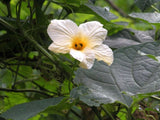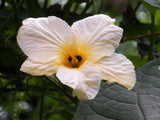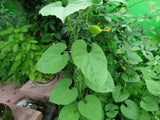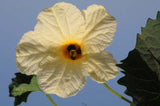🌿 Product Description: Momordica subangulata ssp. renigera Seeds
Discover a rare and storied gourd vine—the Teasle Gourd, locally called “Kakrol” or “Bhat Karela” in parts of Northeast India and Bangladesh. These seeds offer a chance to grow a plant that combines cultural heritage, culinary use, and fascinating wild beauty.
🏵 Botanical & Bloom Highlights
-
Bloom Color: Cream‑yellow flowers, typically marked with distinct dark nectar spots at the base of the corolla—subtle and auspicious, emerging singly from leaf axils.
-
Vine Habit: A vigorous dioecious (male and female flowers on separate plants) climber reaching 2–10 m, with quadrangular grooved stems and tendrils for support.
-
Fruit & Seeds: Female vines bear firm, oval fruits ~5–7 cm long covered in small tubercles aligned in rows—harvested young as a vegetable. Inside are vibrant seeds beneath crimson flesh.
🌡 Hardiness & Growing Conditions
-
USDA Hardiness Zones: Zones 8–11—tender perennial in frost‑free climates. Can be grown as an annual or under protection in cooler areas.
-
Temperature & Soil: Prefers warm, humid environments with moderate moisture and well‑draining soil. Thrives with partial shade to full sun in subtropical zones.
🌸 Fragrance & Wildlife Use
-
Fragrance: No notable fragrance; the appeal lies in its unusual flowers and textured fruits.
-
Pollinators & Wildlife:
-
Native bees are likely drawn to the nectar‑rich, spotted flowers.
-
Although documented data on butterflies or moth larvae feeding on this vine are limited, community observations suggest Common Evening Brown and Conjoined Swift butterflies have utilized Momordica vines in similar regions.
-
🌎 Cultural Significance & Uses
-
Culinary Tradition: Consumed as a seasonal vegetable in Northeast India and Bangladesh. Known as “meetha karela” when young—offering a milder, less bitter taste than other gourds. Often stir‑fried or curried with local spices.
-
Ethnobotanical Roots: Indigenous to the Himalayan foothills and Southeast Asia, this species has long been part of rural diets and kitchen gardens among tribal communities. Its nomenclature and identity have been refined through taxonomic work to distinguish it from similar species like Momordica dioica and M. cochinchinensis.
🔎 Interesting Botanical Insights
-
M. subangulata ssp. renigera was historically misidentified as other gourds—modern herbarium research confirms its distinct smooth leaves (unlobed or only faintly lobed), lack of petiolar glands, and characteristic tubercled fruit ridge pattern.
-
Genetic studies reveal its diploid chromosome count (2n = 56), and hybrid research with M. dioica has demonstrated intermediate traits and early sprouting vigor in F₁ hybrids.
-
Investigations into seed extracts indicate antioxidant and cytotoxic potential—suggesting that traditional culinary usage intersects with emerging nutritional interest.
🌱 Growing Tips
-
Separate vines: Grow both male and female plants to enable fruit set (dioecious nature).
-
Planting: Sow seeds 1 cm deep in warm soil; germination favors high humidity.
-
Support: Provide trellis or fence; vines climb 2–3 m quickly.
-
Water & Light: Keep soil evenly moist; partial shade works well during hottest hours.
-
Harvesting: Pick fruits when 5–7 cm long and firm—before spines harden or tubercles enlarge.
🌟 Why You’ll Love These Seeds
-
Cultural depth: A vine tied to Northeast Indian cooking traditions and botanical re‑discovery.
-
Garden intrigue: Cream‑yellow spotted blossoms, textured fruits, and lively vine growth.
-
Wildlife-friendly: Nectar rewards for bees and possible host clues for regional butterflies.
-
Botanical curiosity: A species with complex taxonomy, hybrid potential, and emerging nutritional study.
Sow these seeds to grow not just a vine, but a living tapestry—where culture, flavor, pollinators, and botanical stories intertwine in your garden.










